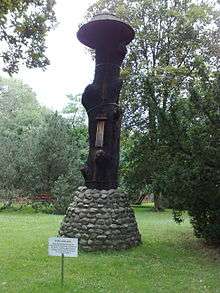Honey hunting
Honey hunting or honey harvesting is the gathering of honey from wild bee colonies and is one of the most ancient human activities and is still practiced by aboriginal societies in parts of Africa, Asia, Australia and South America. Some of the earliest evidence of gathering honey from wild colonies is from rock painting, dating to around 8,000 BC. In the Middle Ages in Europe, the gathering of honey from wild or semi-wild bee colonies was carried out on a commercial scale.
Gathering honey from wild bee colonies is usually done by subduing the bees with smoke and breaking open the tree or rocks where the colony is located, often resulting in the physical destruction of the colony.

Africa
Honey hunting in Africa is a part of the indigenous culture in many parts and hunters have hunted for thousands of years.
Asia
Nepal
A documentary by freelance photo journalists Diane Summers and Eric Valli on the Honey hunters of Nepal [1]documents Gurung tribesmen of west-central Nepal entering the jungle in search of wild honey where they use indigenous tools under precarious conditions to collect honey.
Twice a year high in the Himalayan foothills of central Nepal teams of men gather around cliffs that are home to the world's largest honeybee, Apis laboriosa. As they have for generations, the men come to harvest the Himalayan cliff bee's honey.
This was also documented in a BBC2 documentary in August 2008 entitled Jimmy and the Wild Honey Hunters-Sun. An English farmer travelled into the Himalayan foothills on a honey hunting expedition. The world's largest honeybee, A. laboriosa is over twice the size of those in the UK where their larger bodies have adapted to the colder climate for insulation. The documentary involved ascending a 200-foot rope ladder and balancing a basket and a long pole to chisel away at a giant honey comb of up to 2 million bees and catch it in the basket.
For centuries the Gurung people of the country of Nepal risked their lives to collect wild cliff-honey. Photos of Andrew Newey capture this dying tradition.[2]
India and Bangladesh
In the Sunderban forest, shared by West Bengal and Bangladesh, estuarine forests are the area of operation of honey hunters.[3] They are known as "Mawals". This is a dangerous occupation as many honeyhunters die in tiger attacks which are common in this area. The harvest ritual, which varies slightly from community to community, begins with a prayer and sacrifice of flowers, fruits, and rice. Then a fire is lit at the base of the cliff to smoke the bees from their honeycombs.
Europe
Function

As early as the Stone Age, people collected the honey of wild bees, but this was not done commercially. From the Early Middle Ages it became a trade, known in German-speaking central Europe, for example, as a Zeidler or Zeitler, whose job it was to collect the honey of wild, semi-wild or domestic bees in the forests. Unlike modern beekeepers, they did not keep the bees in man-made wooden beehives. Instead, they cut holes as hives in old trees at a height of about six meters and fitted a board over the entrance. Whether a colony of bees nested there or not depended entirely on the natural environment and that could change every year. The tree tops were also cut off in order to prevent wind damage.
Distribution
Extremely valuable, if not a prerequisite for tree beekeeping, were conifer stands. Important locations for honey hunting in the Middle Ages were in the regions of the Fichtel Mountains and the Nuremberg Imperial Forest. In Bavaria forest beekeeping is recorded as early as the year 959 in the vicinity of Grabenstätt. But even in the area of today's Berlin, there was extensive honey gathering, especially in the then much larger Grunewald.
In the area around Nuremberg there are still numerous references to an earlier flourishing honey hunting tradition such as the castle of Zeidlerschloss in Feucht. Honey was important for Nuremberg's gingerbread production; the Nuremberg Reichswald ("The bee garden of the Holy Roman Empire") provided plenty of it.
References
- Expedition, Go For Nepal Treks &. "A Day with Honey Hunters in Nepal". Go For Nepal Treks & Expedition. Retrieved 2020-02-02.
- https://www.theguardian.com/travel/gallery/2014/feb/27/honey-hunters-nepal-in-pictures
- http://news.bbc.co.uk/2/hi/programmes/from_our_own_correspondent/2969234.stm
Literature
- Eva Crane: The world history of beekeeping and honey hunting. Duckworth, London, 2000. ISBN 0-7156-2827-5.
- Hermann Geffcken, Monika Herb, Marian Jeliński und Irmgard Jung-Hoffman (Hrsg.): Bienenbäume, Figurenstöcke und Bannkörbe. Fördererkreis d. naturwiss. Museen Berlins, Berlin 1993. ISBN 3-926579-03-X.
- Karl Hasel, Ekkehard Schwartz: Forstgeschichte. Ein Grundriss für Studium und Praxis. 2nd, updated edition. Kessel, Remagen, 2002, ISBN 3-935638-26-4.
- Richard B. Hilf: Der Wald. Wald und Weidwerk in Geschichte und Gegenwart – Erster Teil [reprint]. Aula, Wiebelsheim, 2003, ISBN 3-494-01331-4.
- Klaus Baake: Das Zeidelprivileg von 1350. Munich, 1990.
- Mark Synnott: “The Last Honey Hunter” p. 80. National Geographic. Vol. 232. No. 1. July 2017.